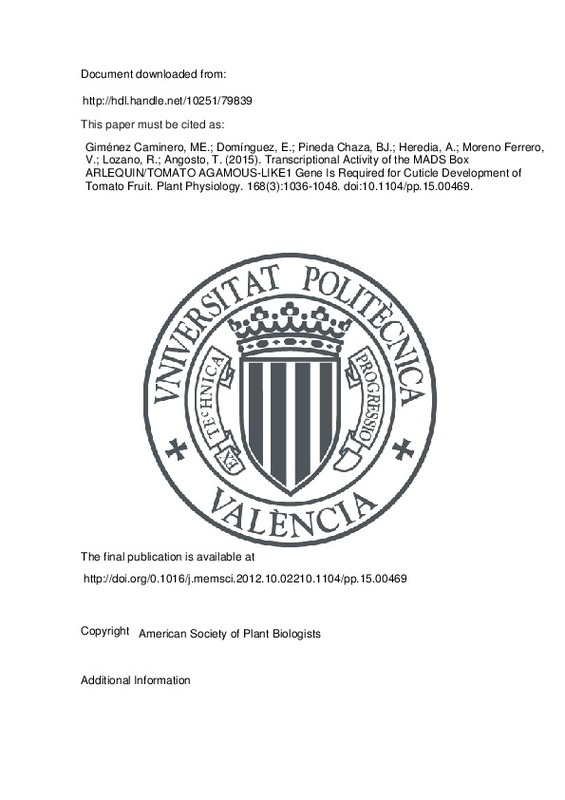JavaScript is disabled for your browser. Some features of this site may not work without it.
Buscar en RiuNet
Listar
Mi cuenta
Estadísticas
Ayuda RiuNet
Admin. UPV
Transcriptional Activity of the MADS Box ARLEQUIN/TOMATO AGAMOUS-LIKE1 Gene Is Required for Cuticle Development of Tomato Fruit
Mostrar el registro sencillo del ítem
Ficheros en el ítem
| dc.contributor.author | Giménez Caminero, Maria Estela
|
es_ES |
| dc.contributor.author | Domínguez, Eva
|
es_ES |
| dc.contributor.author | Pineda Chaza, Benito José
|
es_ES |
| dc.contributor.author | Heredia, Antonio
|
es_ES |
| dc.contributor.author | Moreno Ferrero, Vicente
|
es_ES |
| dc.contributor.author | Lozano, Rafael
|
es_ES |
| dc.contributor.author | Angosto, Trinidad
|
es_ES |
| dc.date.accessioned | 2017-04-20T07:39:53Z | |
| dc.date.available | 2017-04-20T07:39:53Z | |
| dc.date.issued | 2015-07 | |
| dc.identifier.issn | 0032-0889 | |
| dc.identifier.uri | http://hdl.handle.net/10251/79839 | |
| dc.description.abstract | [EN] Fruit development and ripening entail key biological and agronomic events, which ensure the appropriate formation and dispersal of seeds and determine productivity and yield quality traits. The MADS box gene ARLEQUIN/TOMATO AGAMOUS-LIKE1 (hereafter referred to as TAGL1) was reported as a key regulator of tomato (Solanum lycopersicum) reproductive development, mainly involved in flower development, early fruit development, and ripening. It is shown here that silencing of the TAGL1 gene (RNA interference lines) promotes significant changes affecting cuticle development, mainly a reduction of thickness and stiffness, as well as a significant decrease in the content of cuticle components (cutin, waxes, polysaccharides, and phenolic compounds). Accordingly, overexpression of TAGL1 significantly increased the amount of cuticle and most of its components while rendering a mechanically weak cuticle. Expression of the genes involved in cuticle biosynthesis agreed with the biochemical and biomechanical features of cuticles isolated from transgenic fruits; it also indicated that TAGL1 participates in the transcriptional control of cuticle development mediating the biosynthesis of cuticle components. Furthermore, cell morphology and the arrangement of epidermal cell layers, on whose activity cuticle formation depends, were altered when TAGL1 was either silenced or constitutively expressed, indicating that this transcription factor regulates cuticle development, probably through the biosynthetic activity of epidermal cells. Our results also support cuticle development as an integrated event in the fruit expansion and ripening processes that characterize fleshy-fruited species such as tomato. | es_ES |
| dc.description.sponsorship | This work was supported by the Ministerio de Ciencia e Innovacion (grant nos. BIO2009-11484, AGL2012-32613, AGL2012-40150-C03-01, and AGL2012-40150-C03-02) and by the European Commission through the Junta para la Ampliacion de Estudios-Doc program of the Consejo Superior de Investigaciones Cientificas (to B.P.). | en_EN |
| dc.language | Inglés | es_ES |
| dc.publisher | American Society of Plant Biologists | es_ES |
| dc.relation.ispartof | Plant Physiology | es_ES |
| dc.rights | Reserva de todos los derechos | es_ES |
| dc.subject | Transpiration barrier properties | es_ES |
| dc.subject | Lycoppersicon-esculentum | es_ES |
| dc.subject | Solanum-Lycopersicon | es_ES |
| dc.subject | Ripening-inhibitor | es_ES |
| dc.subject | Chalcone synthase | es_ES |
| dc.subject | Arabidopsis thaliana | es_ES |
| dc.subject | Lignin biosynthesis | es_ES |
| dc.subject | Molecular cloning | es_ES |
| dc.subject.classification | GENETICA | es_ES |
| dc.title | Transcriptional Activity of the MADS Box ARLEQUIN/TOMATO AGAMOUS-LIKE1 Gene Is Required for Cuticle Development of Tomato Fruit | es_ES |
| dc.type | Artículo | es_ES |
| dc.identifier.doi | 10.1104/pp.15.00469 | |
| dc.relation.projectID | info:eu-repo/grantAgreement/MICINN//BIO2009-11484/ES/Aislamiento Y Caracterizacion Funcional De Un Regulador Clave Del Desarrollo Reproductivo De Tomate/ | es_ES |
| dc.relation.projectID | info:eu-repo/grantAgreement/MINECO//AGL2012-32613/ES/GENETICA DE LA FORMACION DE LA CUTICULA DE TOMATE: IMPLICACIONES EN EL AGRIETADO Y ECONOMIA DEL AGUA/ | es_ES |
| dc.relation.projectID | info:eu-repo/grantAgreement/MINECO//AGL2012-40150-C03-01/ES/IDENTIFICACION, ETIQUETADO Y ANALISIS FUNCIONAL DE GENES IMPLICADOS EN EL CUAJADO DEL FRUTO DE TOMATE Y TOLERANCIA A LA SALINIDAD EN ESPECIES SILVESTRES RELACIONADAS/ | es_ES |
| dc.relation.projectID | info:eu-repo/grantAgreement/MINECO//AGL2012-40150-C03-02/ES/Identificación, etiquetado y análisis funcional de genes implicados en el cuajado del fruto de tomate y tolerancia a la salinidad en especies silvestres relacionadas/ | es_ES |
| dc.rights.accessRights | Abierto | es_ES |
| dc.contributor.affiliation | Universitat Politècnica de València. Instituto Universitario Mixto de Biología Molecular y Celular de Plantas - Institut Universitari Mixt de Biologia Molecular i Cel·lular de Plantes | es_ES |
| dc.contributor.affiliation | Universitat Politècnica de València. Escuela Técnica Superior de Ingeniería Agronómica y del Medio Natural - Escola Tècnica Superior d'Enginyeria Agronòmica i del Medi Natural | es_ES |
| dc.description.bibliographicCitation | Giménez Caminero, ME.; Domínguez, E.; Pineda Chaza, BJ.; Heredia, A.; Moreno Ferrero, V.; Lozano, R.; Angosto, T. (2015). Transcriptional Activity of the MADS Box ARLEQUIN/TOMATO AGAMOUS-LIKE1 Gene Is Required for Cuticle Development of Tomato Fruit. Plant Physiology. 168(3):1036-1048. doi:10.1104/pp.15.00469 | es_ES |
| dc.description.accrualMethod | S | es_ES |
| dc.relation.publisherversion | http://doi.org/0.1016/j.memsci.2012.10.02210.1104/pp.15.00469 | es_ES |
| dc.description.upvformatpinicio | 1036 | es_ES |
| dc.description.upvformatpfin | 1048 | es_ES |
| dc.type.version | info:eu-repo/semantics/publishedVersion | es_ES |
| dc.description.volume | 168 | es_ES |
| dc.description.issue | 3 | es_ES |
| dc.relation.senia | 304812 | es_ES |
| dc.identifier.eissn | 1532-2548 | |
| dc.identifier.pmcid | PMC4741332 |







![[Cerrado]](/themes/UPV/images/candado.png)

